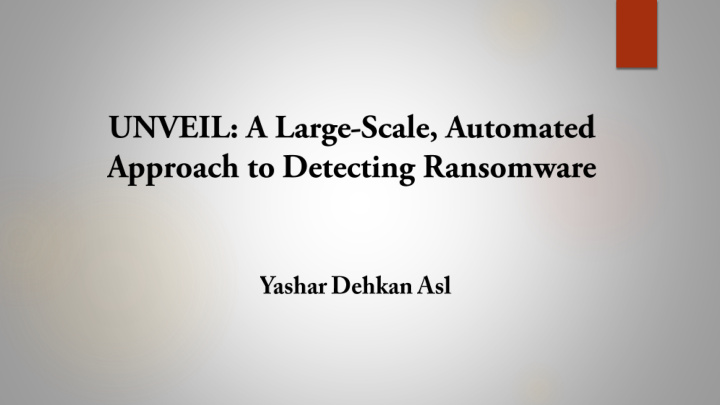



Ransom : Money that is paid in order to free someone who has been captured or kidnapped. -Merriam-Webster Ransomware : A malware designed to block access to a computer system, files, screen, disk or etc. until the requested amount of money is paid.
First Ransomware Virus: AIDS Trojan (1989) Recent Years Locky Cerber CrypyXXX 3.0 Dogspectus
Two major types: Locker Ransomware (Computer locker) • Denies the access to computer or device Crypto Ransomware (Data locker) • Denies the access to files or data
Persistent desktop message • Indiscriminate encryption and deletion of the user ’ s private files. • Selective encryption and deletion of the user ’ s private files based on • certain attributes
Detecting File Lockers • Detecting Screen Lockers •
Generating Artificial User Environments • Filesystem Activity Monitor • I/O Data Buffer Entropy . Constructing Access Patterns
Different strategies on ransomware families
Taking automatic screenshots to detect screen locking ransomware • Measuring the structural similarity by comparing local petterns of • two screenshots Closing open windows for screenshots from persistent changes, to • avoid false positives Extracting the text within the area •
Generating User Environments • Valid Content • File Path • Time Attributes
Filesystem Activity Monitor • UNVEIL monitors filesystem I/O activity using the Windows Filesystem Minifilter Driver • Monitoring and retrieving logs of entire system • UNVEIL ’ s monitor sets callback on all I/O request to the filesystem.
Desktop Lock Monitor • Captures screenshots from outside of dynamic analysis environment • Converts the image to floating point data then calculates parameters
Two experiments: To show the system can detect known ransomware samples To show that UNVEIL can detect previously unknown ransomware samples
Experimental Setup • Build up a prototype on top of Cuckoo Sandbox • Use 56 VMs with Windows XP SP3 • Multiple NTFS drives on each VM • Take anti-evasion measures against popular tricks • Permit controlled access to the internet
Ground Truth (Labeled) Dataset • Filesystem Activity of Benign Application with Potential Ransomware-like Behavior • Similarity Threshold
Detecting Zero-Day Ransomware Detecting Results • Evaluation of false positive Evaluation of false negative Early Warning •
It ’ s always possible that attackers find ways to fingerprint the automatically generated user environment and avoid it. Malware might encrypt part of a file, not all of it, or it might make the file unreadable. Text extraction can be improved Ransomware may run at kernel level
Recommend
More recommend